Tired of your garden getting soggy during a heavy rain and drying up with the summer heat? Building a water wise rain garden with the right plants will help soak up excess rainwater and bank it for those hot and dry days. We have compiled a list of plants that will ensure your garden has beautiful summer blooms that support local pollinators like bees and birds, while helping save water.
Bergamot (bee balm)
Monarda fistulosa

Range: Native to most of North America.
Season: Fragrant floral crowns of coral, pink, or purple appear in June and persists into September.
Type: Fast-growing rhizomatous herbaceous perennial. 2-5′ height and forms colonies.
Sun: Prefers full sun but tolerates partial shade. Heat-tolerant.
Soil: Prefers rich alkaline soil. Tolerates both wet and dry conditions. Drought-tolerant. Clay-tolerant.
Attributes:
A well-known honey-plant for pollinators like bees, for which it was named. Attracts longer-tongued pollinators, like hummingbirds. Deer and rabbit resistant. Requires good air-circulation to avoid powdery-mildew on leaves in wet and humid conditions.
Uses:
A good substitute for invasive Eurasian honeysuckles, if you’re set on those tubular textures in your flower garden. This plant has a long history of use as a medicinal plant by Algonquian, Iroquoian, and Siouan nations and is a decent source of thymol (oil of thyme).
Fun Facts:
Monarda herbal tea, made using bee balms, has an aroma of orange and spice, and is reminiscent of Earl Grey tea (which uses the citrus-fruit of the same name, Bergamot Orange (Citrus bergamia)). Its cousin, the fiery red Crimson Beebalm (M. didyma), is also called ‘Oswego tea’ and is native to the east coast of N. America.
Pearly Everlasting
Anaphalis margaritacea, A. triplinervis
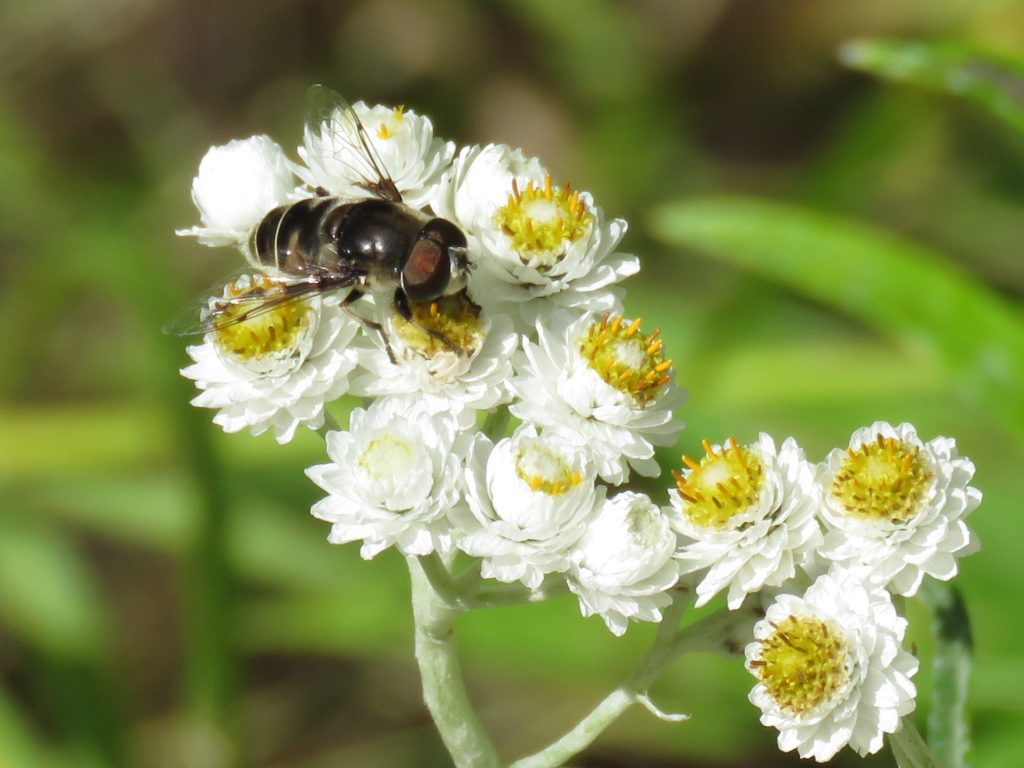
Range: Native to North America and East Asia.
Season: Stiff white flowers bloom on silvery green stems from July to August.
Type: Perennial wildflower. 1-3′ tall.
Sun: Grows in full-sun to part-shade.
Soil: Likes well-drained sandy loam. Tolerates drought and nutrient-poor soils.
Attributes:
Hostplant for American painted-lady butterflies (Vanessa virginiensis). Attracts pollinators. Deer and rabbit resistant.
Uses:
Popular for pollinator gardens. A long-lasting addition to dried flower arrangements, which alludes to its name. Used in salves for burns in folk-medicine.
Fun Facts: Has separate male and female plants (dioecious). Relatively low-maintenance!
Yellow Daylily
Hemerocallis flava (syn. H. lilioasphodelus), H. citrina
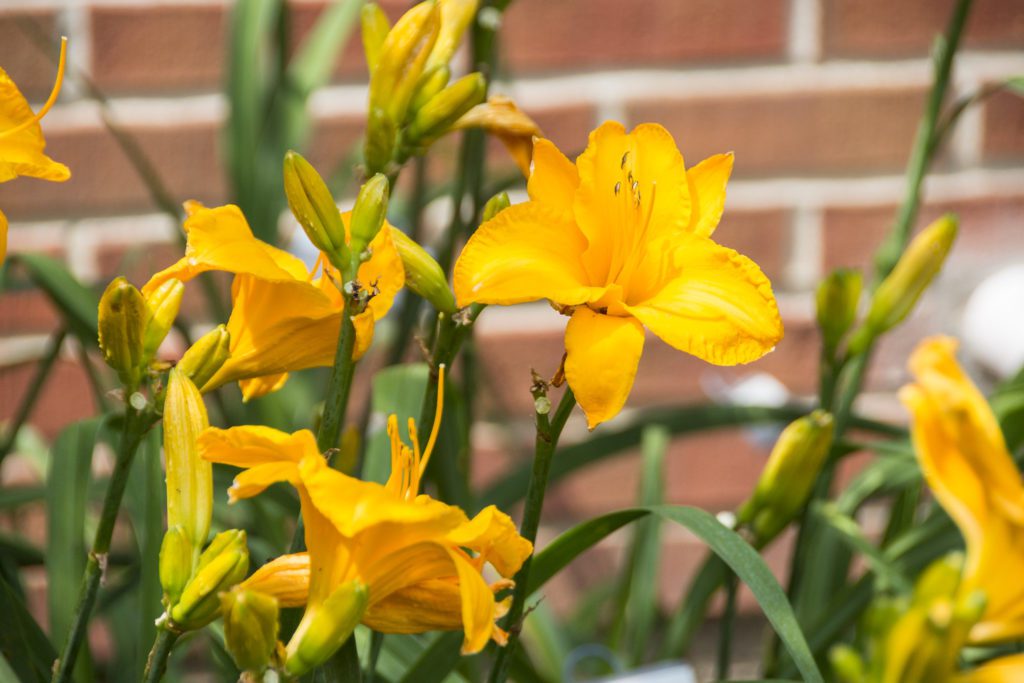
Range: Native to East Asia but naturalised in North America.
Season: Sunny summer yellow flowers are fragrant and bloom from June to July.
Type: Perennial, herbaceous. 1-2′ height and spread.
Sun: Thrives in full-sun or part-sun.
Soil: Adapts to both dry and moist soil conditions. Water-wise.
Attributes:
Attracts bees, butterflies and hummingbirds.
Uses:
Compact bunching/mounding/clumping habit and ribbon-like leaves provide a neat texture for bordering. In East Asia, buds are dried and used for thickening soups and eaten in stir-fries.
Fun Facts:
Low-maintenance and pollution-tolerant. Flowers and buds are edible, unlike with true lilies (Liliaceae spp.)—however, they remain toxic to cats. Its cousin, the orange daylily (Hemerocallis fulva), is an invasive non-native.
Spotted Joe-pye Weed
Eutrochium maculatum
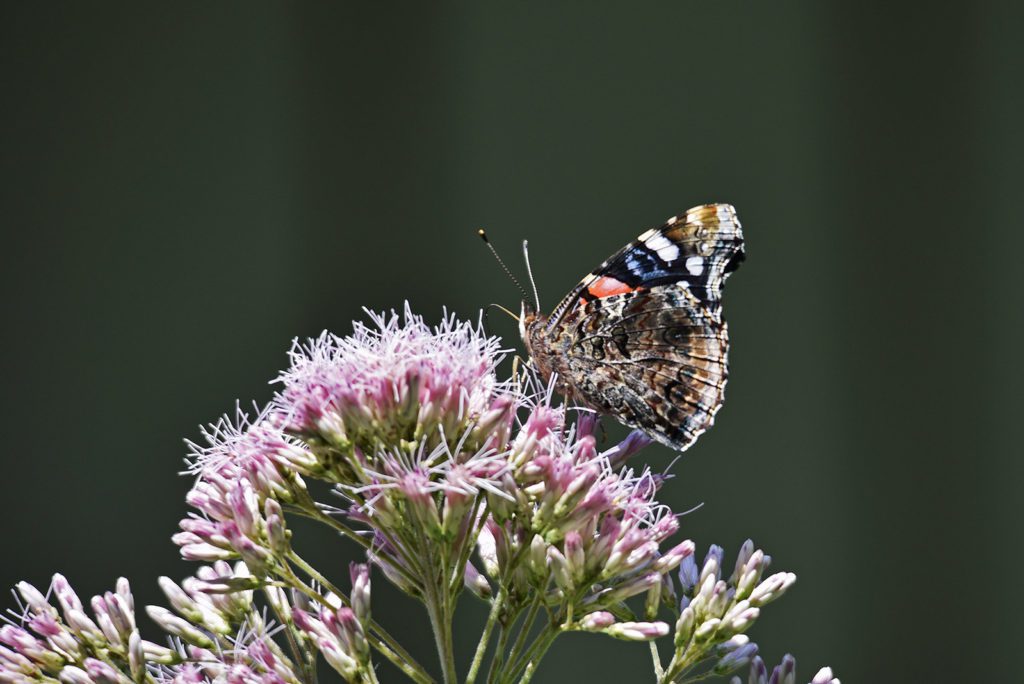
Range: Native to North America.
Season: Blooms of lilac and pink flower in late summer.
Type: Perennial, herbaceous. 3-5′ tall and wide.
Sun: Prefers partial to full sun.
Soil: Enjoys moist, sandy loam. Very tolerant of flood and drought conditions.
Attributes:
Is a companion-plant to milkweeds (Asclepias spp.). Larval host to several native moth species, including the ruby tiger moth (Phragmatobia fuliginosa rubricosa) and the enigmatic Clymene moth (Haploa clymene).
Uses:
Attracts many bee species and butterflies, like the red admiral butterfly (Vanessa atalanta, pictured above); great for butterfly and pollinator gardens.
Fun Facts:
Low-maintenance and tolerant of a wide range of soil conditions. Grows well but doesn’t get too weedy. Gets its common name from the purple spots on its green stems.
Sparkleberry (farkleberry, huckleberry)
Vaccinium arboreum
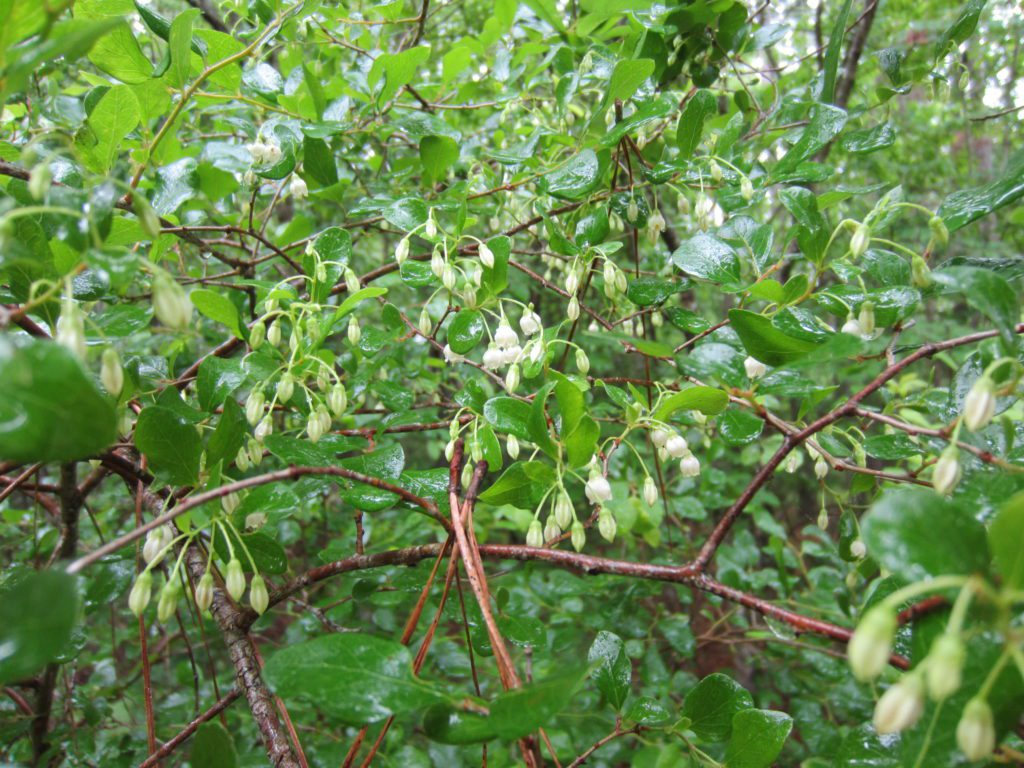
Range: Native to meadows, dunes, and hillsides in North America.
Season: Fragrant, white fairy-like bellflowers appear in spring and last until summer.
Type: Perennial ericaceous shrub. Variable 6-30’ height and 4-15′ spread.
Sun: Full sun to part shade. Heat-tolerant.
Soil: Prefers acidic soils. Tolerates both wet and dry conditions. Drought –tolerant after establishing.
Attributes:
A hostplant to striped hairstreak butterfly larvae (Satyrium liparops). Plays well with azaleas and rhododendrons.
Uses:
Four-season gardens, bird gardens, native gardens.
Fun Facts:
Changes colour each season and a favourite of rain-gardeners! In the autumn, glossy green leaves turn red, and little black berries replace flowers. Grows to about 4.5 metres tall, but in exceptional circumstances, can reach 9 metres. Though related to the blueberry and cranberry, their berries are bitterly tough and so are better suited for birds.
Butterfly Milkweed
Asclepias tuberosa
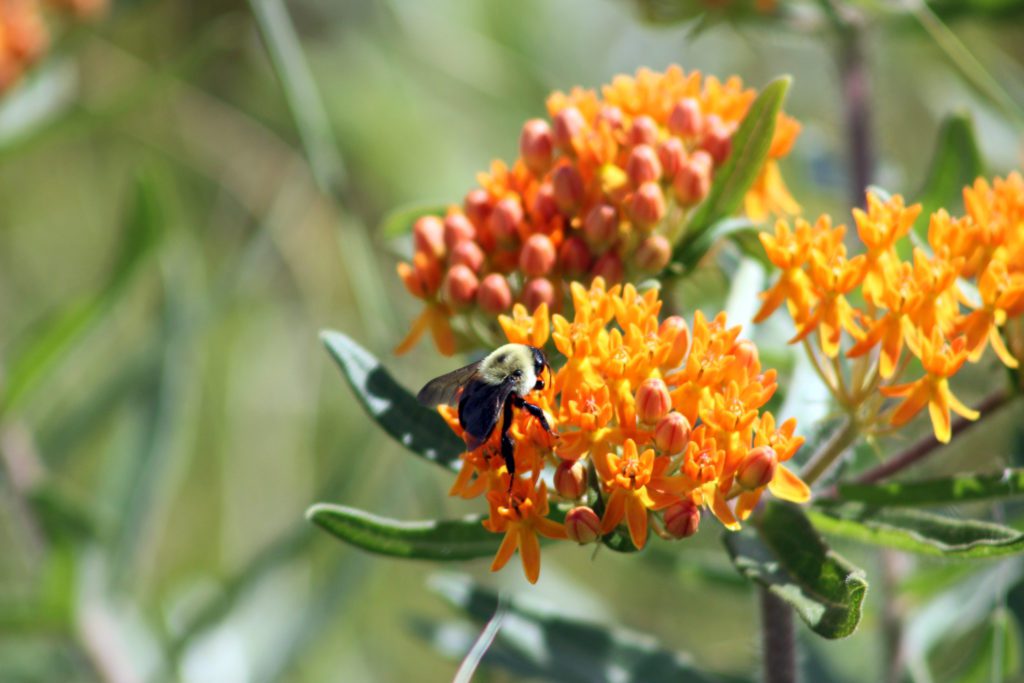
Range:
Native to North America, east of the Rockies (from Quebec and Ontario, through South Dakota and Florida, down to California and Mexico).
Season: Orange star-like blooms form from early summer to early autumn.
Type: Herbaceous perennial. Grows to 1-2′ in height.
Sun: Requires full sun to thrive.
Soil: Tolerates both wet and dry conditions.
Attributes: Larval hostplant for native lepidopterans like Cycnia moths and monarch butterflies.
Uses:
Popular in pollinator gardens.
Fun Facts:
This ostentatious orange cousin of common milkweed (Asclepias syriaca) survives droughts with a tuberous taproot. Also comes in a yellow cultivar called ‘Hello Yellow’. Despite its common name, this milkweed brings all the bees to the yard!
Rose Milkweed (swamp milkweed)
Asclepias incarnata
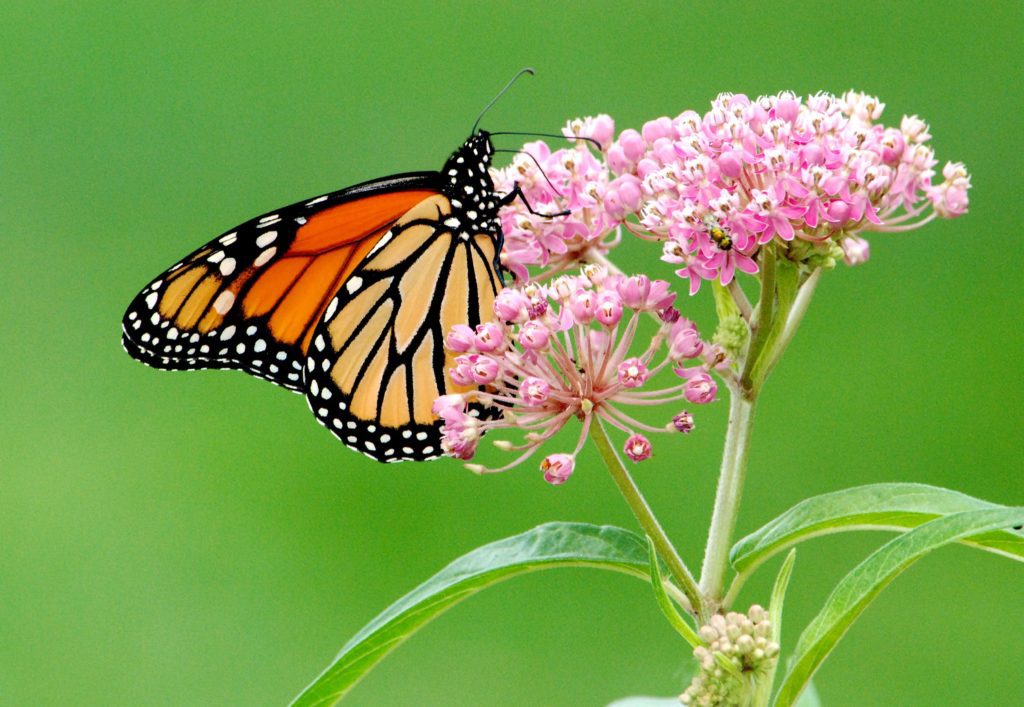
Range: Native to North America.
Season:
Pink, mauve, or white star-like blooms from early to late summer, producing a fragrance reminiscent of cinnamon.
Type: Herbaceous perennial. Grows to 1-2′ in height.
Sun: Does best in full-to-partial sun.
Soil: Thrives in damp to wet soil conditions—not drought resistant.
Attributes: Larval hostplant for monarch butterflies.
Uses: Used in butterfly gardens, monarch waystations, and as cut-flowers in vases.
Fun Facts:
One of the best milkweeds to host monarch larvae (Danaus plexippus) due to its high cardenolide content present in its toxic milky latex.
Take the RAIN Garden Master Class and learn to build your own rain garden
Brown-eyed Susan
Rudbeckia hirta
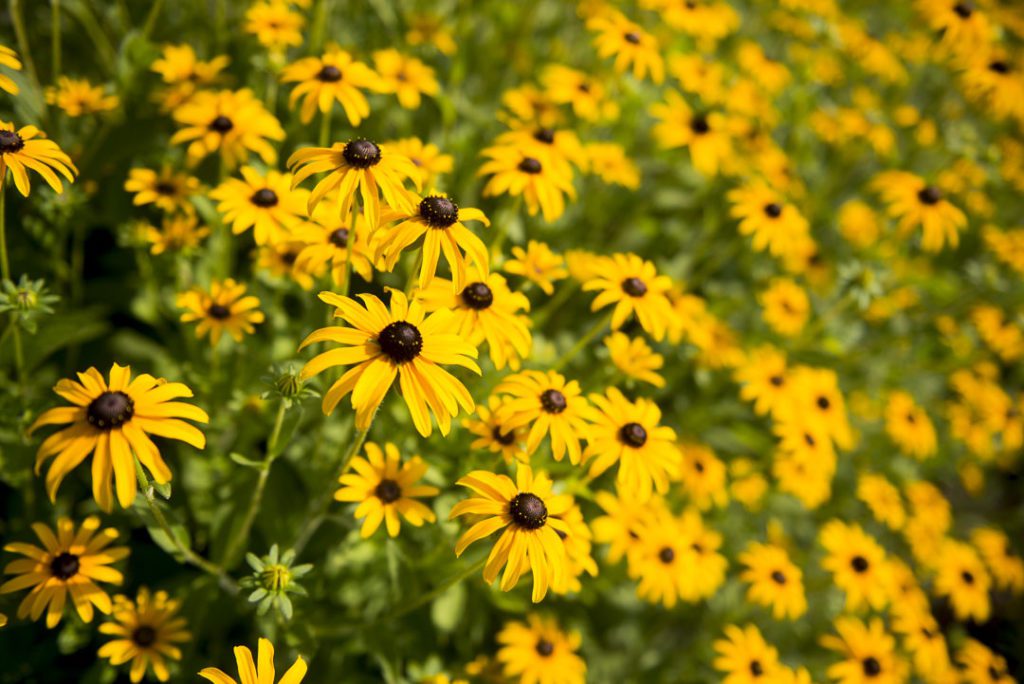
Range: Native east of the Rockies and naturalised in western North America.
Season:
Blooms from June to October. Sunny yellow petals circle a dark brown button of florets (as is common with asters).
Type: Herbaceous perennial. Grows to 1-2′ in height.
Sun: Does best in full-to-partial sun.
Soil: Tolerates both drought and flood conditions.
Attributes:
Attracts many bee species and butterflies. Larval host to checkerspot butterflies and the sunflower patch butterfly (Chlosyne lacinia).
Uses: Gorgeous as cut flowers or for garden bordering.
Fun Facts:
Used in traditional Anishnabek medicine for colds, much like with echinacea, as well as in poultices to treat snakebites.
Blue Vervain (swamp vervain, American vervain)
Verbena hastata
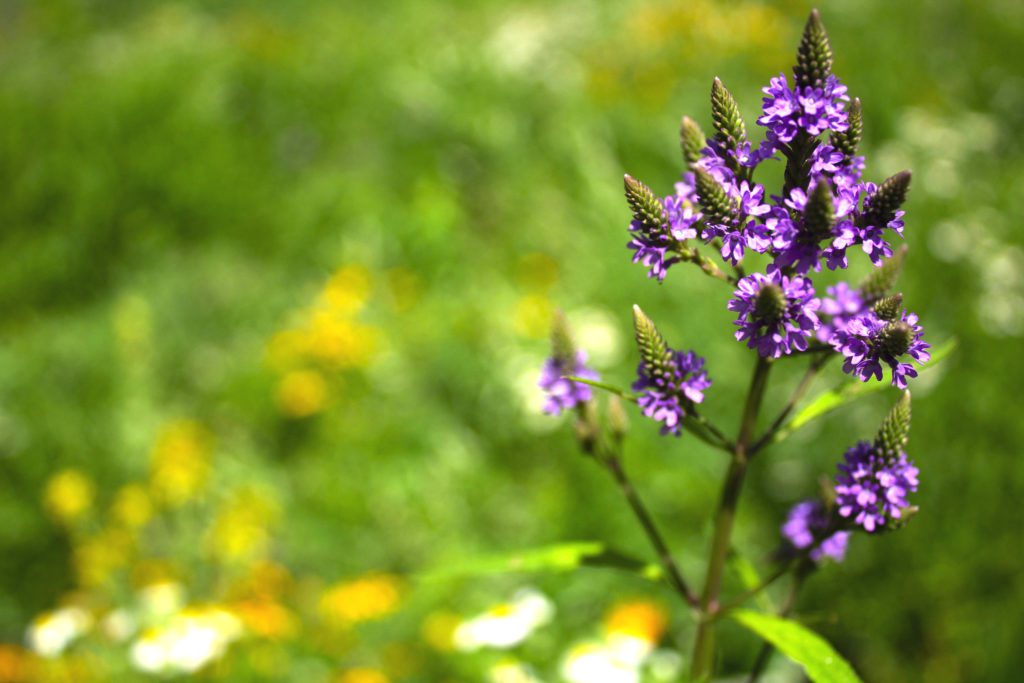
Range: Native to most of North America.
Season: Candelabra-like flower heads bloom violet in July and August.
Type: Herbaceous perennial. Grows to 2-5′ in height.
Sun: Thrives in full sun but will survive in part sun.
Soil: Grows well in moist soil but will survive in dry soil. Flood and drought tolerant.
Attributes:
Larval host for the common buckeye butterfly (Junonia coenia). Deer and rabbit resistant. An important nectar-plant that supports native bees and butterflies. Birds, like cardinals, feed on the seeds.
Uses: Cottage gardening, mass-planting, butterfly gardens.
Fun Facts:
Used in traditional medicine as well as an herbal tea to protect against vampires (in Europe)!
Ox-eye Sunflower (false sunflower)
Heliopsis helianthoides
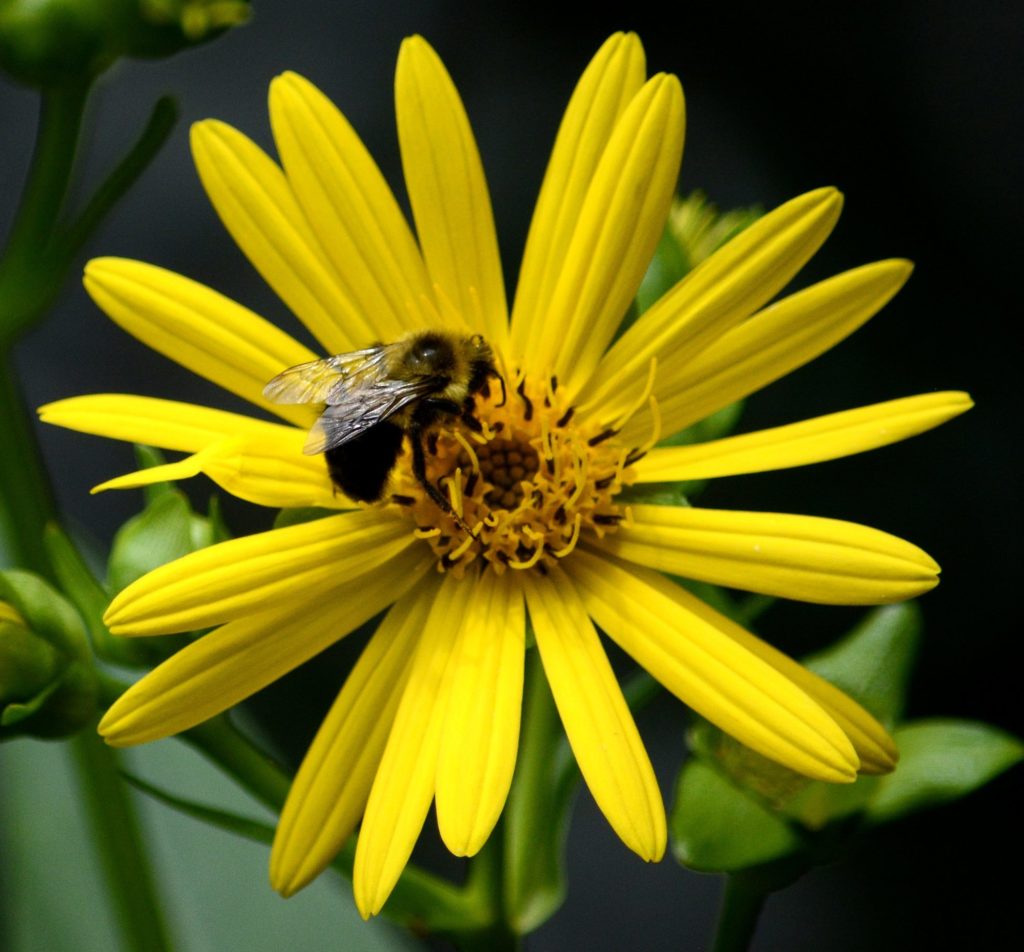
Range: Native to central and eastern North America.
Season: Sun-like flowers appear from mid-summer to early autumn.
Type: Short-lived but hardy perennial forb. Grows to 3-5′ in height.
Sun: Thrives in full sun but will survive in part sun. Heat-tolerant.
Soil: Prefers moist soil but tolerates drought. Clay-tolerant.
Attributes: Resistant against deer, rabbit, and pests. Beloved by pollinators.
Uses: Cut-flowers, pollinator gardens, garden bordering.
Fun Facts: Its seeds are relished by graminivorous songbirds.
Pink Turtlehead
Chelone obliqua, C. lyonii
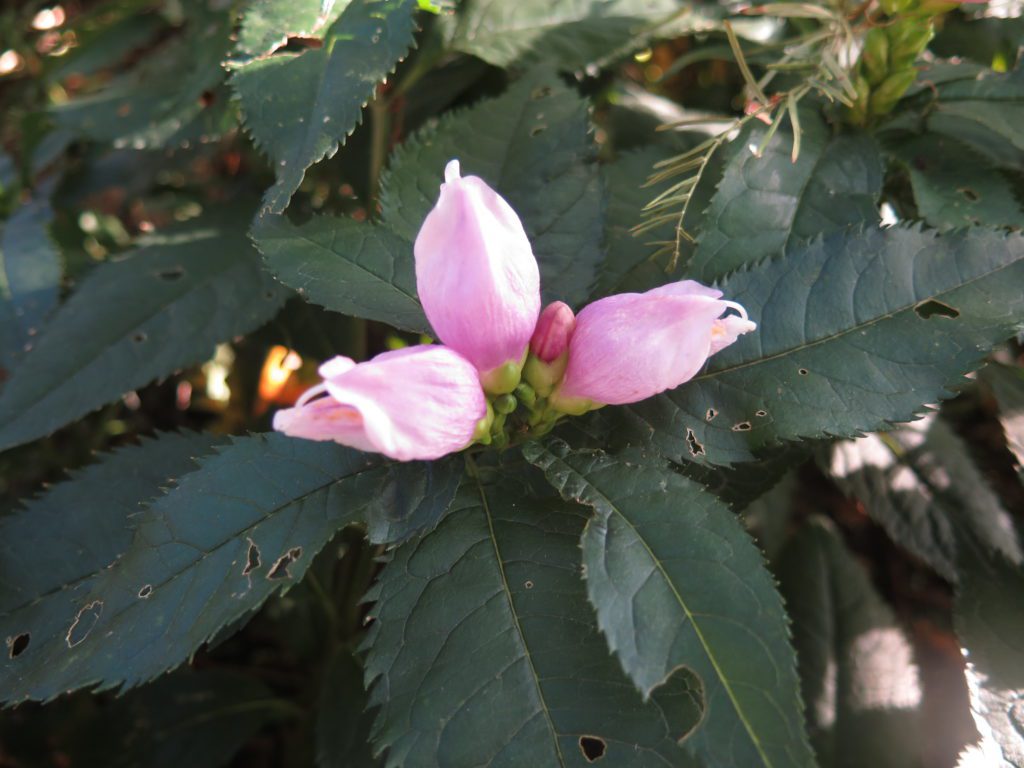
Range: Native to eastern North America.
Season:
Distinctive pink flowers bloom from mid-to-late summer and resemble a turtle’s head, giving the plant its name.
Type: Herbaceous perennial that grows in clumps.
Sun: Enjoys shade but can handle full sun.
Soil: Can grow in neutral, acidic, or alkaline soils. Thrives in disturbed soils, and soggy meadows.
Attributes: Attracts hummingbirds, butterflies, bees, and deer!
Uses: Shade gardening, border plantings, bog gardens.
Fun Facts:
Self-seeds in moist conditions. Low-maintenance.
White Turtlehead
Chelone glabra
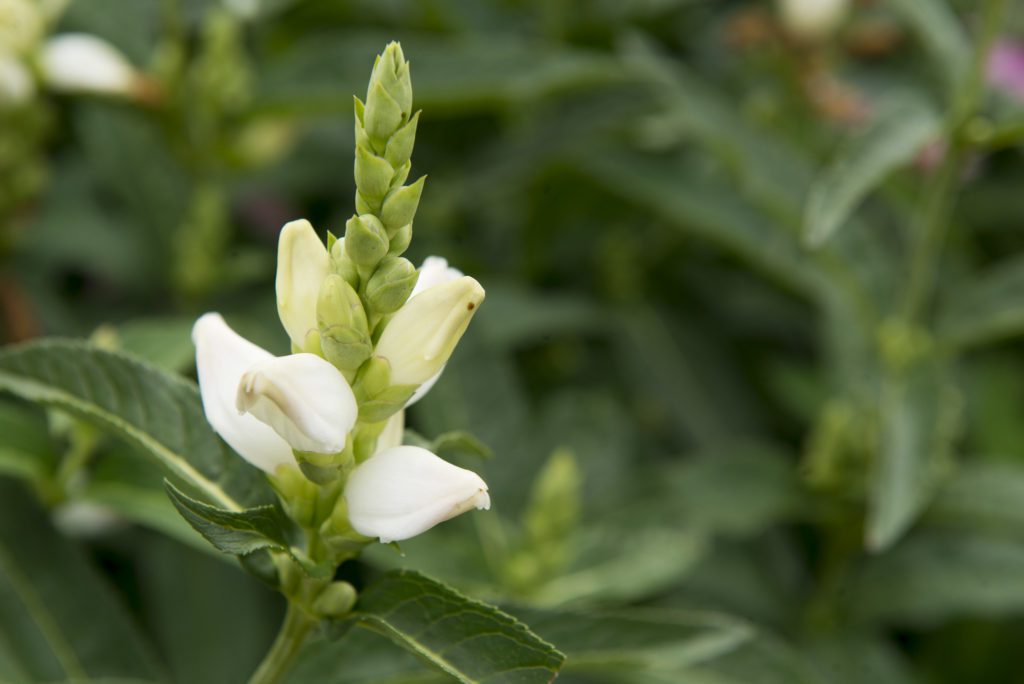
Range: Native to eastern North America.
Season: White turtle-headed flowers bloom from mid-to-late summer.
Type: Perennials, unlike their annual cousins: the snapdragons (Antirrhinum).
Sun: Enjoys shade but can handle full sun.
Soil: Prefers moist soils.
Attributes: Primary larval host for the Baltimore checkerspot butterfly (Euphydryas phaeton).
Uses: Shade gardening, border plantings, bog gardens.
Fun Facts:
First half of the scientific name refers to the nymph who was turned into a tortoise/turtle by the Greek god, Zeus, for missing his wedding.
Ironweed
Vernonia fasciculata, V. altissima
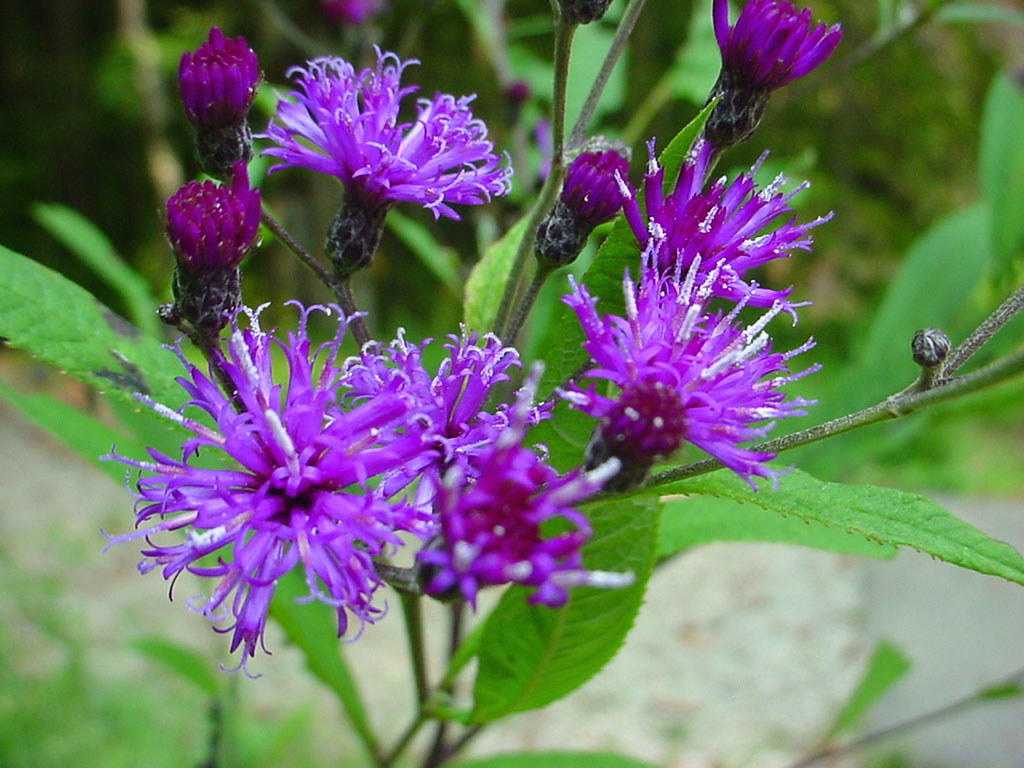
Range: Native to provinces and states east of the Rockies and south of Hudson’s Bay.
Season: Radiantly purple to magenta flowers from July to September.
Type: Herbaceous perennial. Grows 2-6’ tall.
Sun: Full sun.
Soil: Adaptable to wet soils but prefers moist soil. Tolerant of soil disturbance.
Attributes:
Larval host to a few native moth species and tolerant of browsing by deer. Flowers attract pollinators and seeds attract birds.
Uses: Cottage gardens, borders, screen planting.
Fun Facts:
Can become weedy and dominate gardens when given moist conditions.
Blazing Star (gayfeather)
Liatris spicata, L. punctata, L. aspera

Range: Native to central and eastern North America.
Season: Violet blooms, through July to September, also come in white.
Type: Herbaceous perennial. Grows up to 5’ tall.
Sun: Does best in full sun but tolerates partial shade.
Soil:
Prefers moist soil but tolerates some drought after establishing itself in the first growing season. Does not do well in wet winter soil.
Attributes:
Highly popular with pollinators due to its high nectar yield. Larval host for candy-like flower moths (Schinia spp.). Deer-resistant.
Uses: Used medicinally by Iroquoian and Algonquian cultures.
Fun Facts:
Contrasts with coarser broad-leaved plants due to finer texture of leaves and flowers. Dried flowers smell of vanilla and are used in potpourris but can also be used in vases as fresh-cut flowers.
Purple Prairie Clover
Dalea purpurea
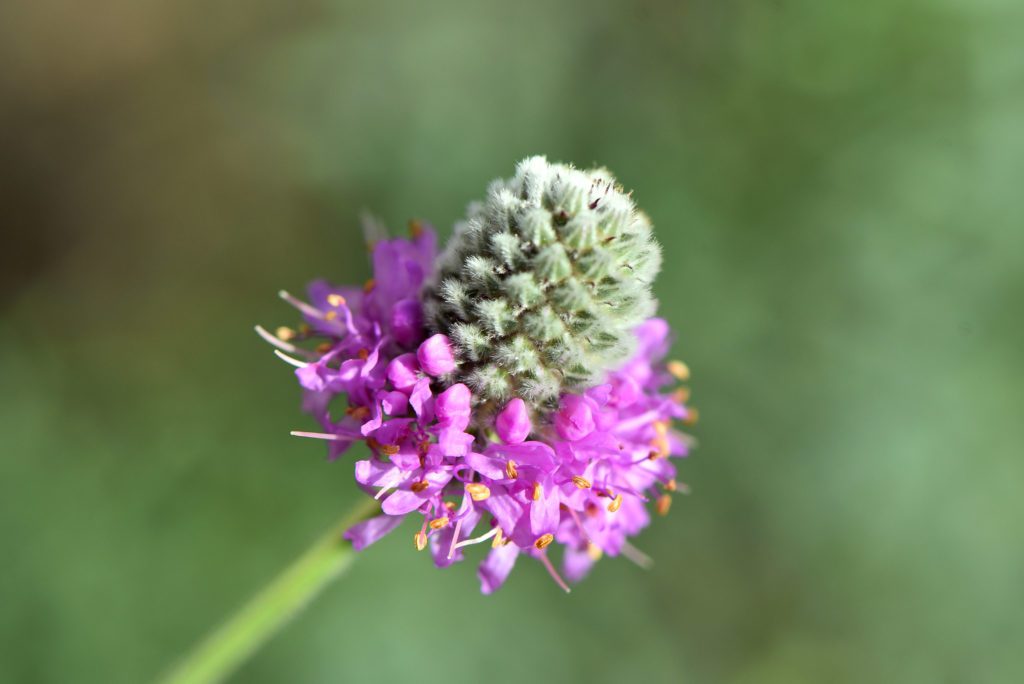
Range: Native to the grasslands and dunes of central North America.
Season: Purple blooms on cattail-like flowerheads in summer.
Type: Herbaceous perennial. Grows up to 3’ tall.
Sun: Requires full sun. Heat-tolerant.
Soil: Prefers soil on the drier side. Drought-tolerant.
Attributes:
Nectar plant that attracts many pollinators. Nutritious source of protein for livestock and native wildlife, like pronghorn.
Uses: Used in teas and traditional medicine by native cultures in central North America.
Fun Facts:
Fire-adapted. Leguminous and thus fixes nitrogen into the soil—because of this, it is used to restore land reclaimed from strip-mining. Its cousin, the White Prairie Clover (Dalea candida), is also proficient at fixing nitrogen into the soil and is largely similar to Purple Prairie Clover.
Purple Coneflower
Echinacea purpurea
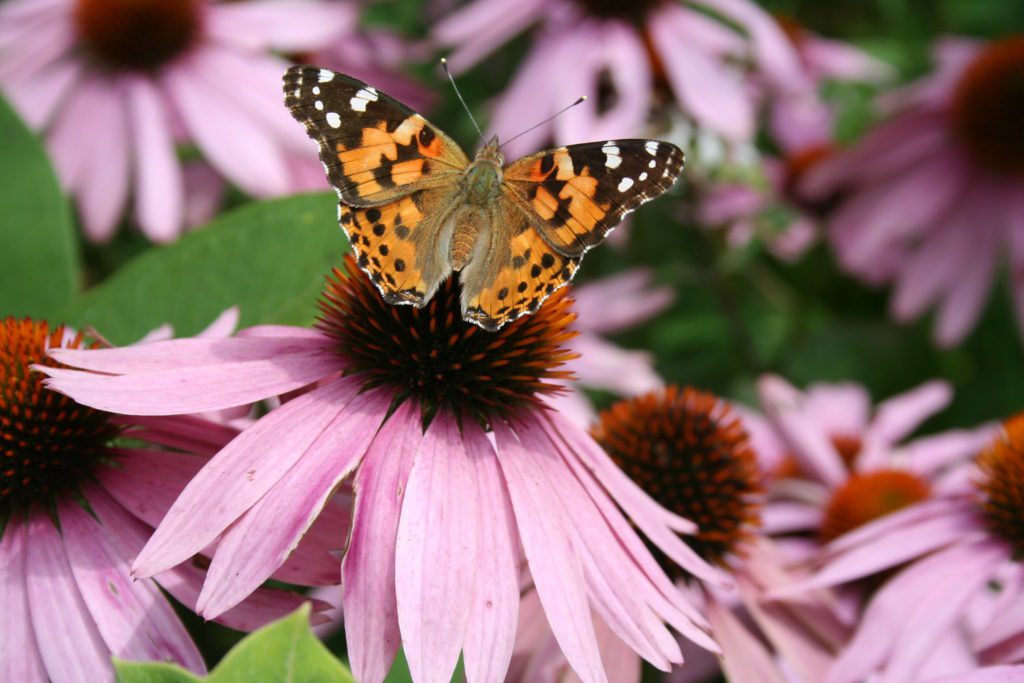
Range: Native to eastern North America.
Season: Blooms from June to September.
Type: Herbaceous perennial. Grows up to 4’ tall.
Sun: Full to partial sun.
Soil: Prefers moist soil, but drought-tolerant after established.
Attributes: Attracts butterflies and bees. Seeds support graminivorous birds, like eastern goldfinches.
Uses: Used in traditional native medicines.
Fun Facts:
Can be planted with black walnut (Juglans nigra).
Swamp Rose Mallow (hardy hibiscus)
Hibiscus moscheutos
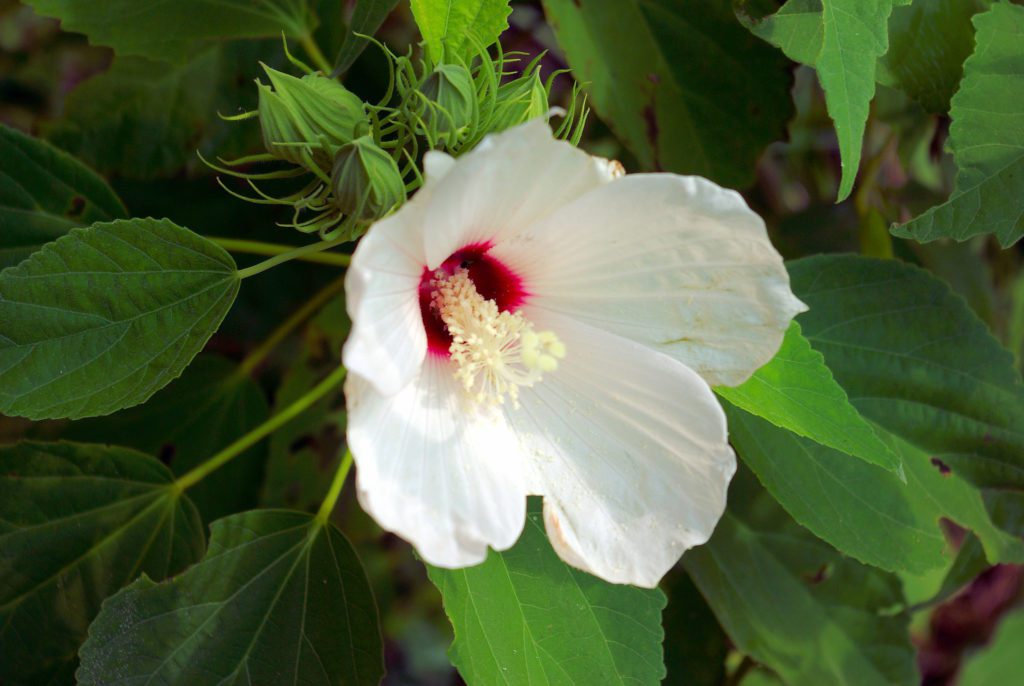
Range: Native to eastern North America.
Season: Light-pink or white-and-red showy bridal blooms in July to September.
Type: Shrub-like herbaceous perennial forb. Grows from 3-7’ tall.
Sun: Full sun.
Soil:
Prefers wet soil but becomes moderately drought-tolerant after becoming established. Flood-
tolerant.
Attributes: Deer-resistant. Attracts pollinators, like hummingbirds and the rose-mallow bee.
Uses: Used in traditional native medicines.
Fun Facts:
Flowers consistently open between 9-11 a.m. Also known by the name “wild cotton” because it is related to the cotton plant and possesses passing resemblance to its flowers.
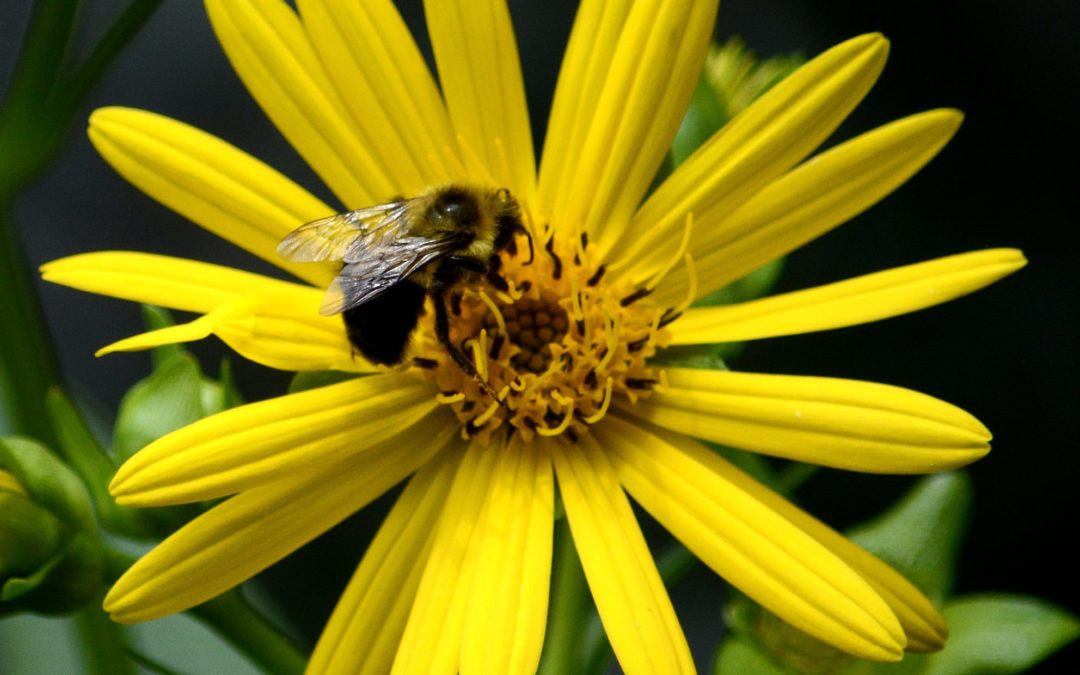
Trackbacks/Pingbacks